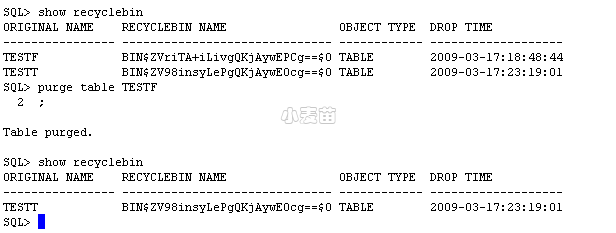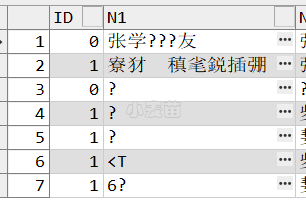合 Oracle回收站及flashback drop
Tags: Oracle闪回flashback drop回收站
- 前言部分
- 导读和注意事项
- 本文简介
- 相关知识点扫盲
- 闪回
- 闪回技术分类
- 闪回删除(Flashback Drop)
- 闪回指定的表
- 执行闪回操作后索引的处理
- 回收空间
- 回收站对象的大小
- 开启回收站
- 回收站相关SQL命令
- 利用job来清空回收站
- MOS
- 官方文档
- Using Flashback Drop and Managing the Recycle Bin
- What Is the Recycle Bin?
- Enabling and Disabling the Recycle Bin
- Viewing and Querying Objects in the Recycle Bin
- Purging Objects in the Recycle Bin
- Restoring Tables from the Recycle Bin
- 实验环境介绍
- 实验目标
- 实验过程
- 实验一:
- 实验二:
- 实验总结
- 实验中用到的SQL总结
前言部分
导读和注意事项
各位技术爱好者,看完本文后,你可以掌握如下的技能,也可以学到一些其它你所不知道的知识,~O(∩_∩)O~:
① Oracle回收站的介绍(开启、关闭、清空)
② 闪回体系中flashback drop的介绍
③ job批量删除回收站中的对象
④ dba_free_space查询速度慢的问题(MOS: Queries on DBA_FREE_SPACE are Slow (文档 ID 271169.1))
本文简介
今天执行健康检查脚本的时候脚本一直卡在了表空间查询这块,瞅了一眼SQL,根据经验小麦苗预估是由于DBA_FREE_SPACE视图的缘故,这个视图若回收站的对象很多的话查询就会非常的慢,接下来单独执行select count(1) from dba_free_space;果然非常的慢,没办法只能先将回收站的数据清理了再来查询表空间了,而回收站大约有200W的数据量,执行purge DBA_RECYCLEBIN非常慢,那就只能采用job的并行技术了,这个在本文最后给出了脚本,这个脚本比较通用,小麦苗以前做开发的时候经常性的用这个脚本,希望各位朋友能掌握。
说到回收站就涉及到闪回,而闪回分很多类,我们今天着重看看flashback drop和回收站。
相关知识点扫盲
闪回
当授权用户犯错,您需要使用工具来更正这些错误。Oracle 数据库 10g 提供了一系列人为错误更正技术,称为闪回。闪回从根本上改变了数据恢复。过去,数据库在几分钟内就可能损坏,但需要几小时才能恢复。利用闪回技术,更正错误的时间与错误发生时间几乎相同。而且它非常易用,使用一条短命令便可恢复整个数据库,而不必执行复杂的程序。闪回技术提供了一个 SQL 界面,能够快速分析和修复人为错误。闪回技术为本地数据损坏提供了细粒度外部分析和修复,如当错误删除客户订单时。闪回技术还支持修复更多广泛的损坏,同时快速避免长时间停机,如当本月的所有客户订单都被删除时。闪回技术是 Oracle 数据库独有的特性,支持各级恢复,包括行、事务、表、表空间和数据库范围。闪回技术是数据库恢复技术历史上一次重大的进步,从根本上改变了数据恢复。
Oracle 9i实现了基于回滚段的闪回查询(Flashback Query)技术,即从回滚段中读取一定时间内对表进行操作的数据,恢复错误的DML操作。
在Oracle 10g中,除提高了闪回查询功能,实现了闪回版本查询、闪回事务查询外,还实现了闪回表、闪回删除和闪回数据库的功能。
采用闪回技术,可以针对行级和事务级发生过变化的数据进行恢复,减少了数据恢复的时间,而且操作简单,通过SQL语句就可以实现数据的恢复,大大提高了数据库恢复的效率。
闪回技术分类
- 闪回查询(Flashback Query):查询过去某个时间点或某个SCN值时表中的数据信息;
- 闪回版本查询(Flashback Version Query):查询过去某个时间段或某个SCN段内表中数据的变化情况;
- 闪回事务查询(Flashback Transaction Query):查看某个事务或所有事务在过去一段时间对数据进行的修改;
- 闪回表(Flashback Table):将表恢复到过去的某个时间点或某个SCN值时的状态;
- 闪回删除(Flashback Drop):将已经删除的表及其关联对象恢复到删除前的状态;
- 闪回数据库(Flashback Database):将数据库恢复到过去某个时间点或某个SCN值时的状态。
注意
- 闪回查询、闪回版本查询、闪回事务查询以及闪回表主要是基于撤销表空间中的回滚信息实现的;
- 闪回删除是基于Oracle 10g中的回收站(Recycle Bin)特性实现的;
- 闪回数据库是基于闪回恢复区(Flash Recovery Area)中的闪回日志来实现的;
- 为了使用数据库的闪回技术,必须启用撤销表空间自动管理回滚信息。
- 如果要使用闪回删除技术和闪回数据库技术,还需要启用回收站、闪回恢复区。
闪回删除(Flashback Drop)
Oracle10g之前,一旦删除了一个表,那么该表就会从数据字典里面删除。要恢复该表,需要进行不完全恢复。Oracle10g以后,当我们删除表时,默认Oracle只是在数据库字典里面对被删的表的进行了重命名,并没有真正的把表删除。 Flashback Drop 是从Oracle 10g 开始出现的,用于恢复用户误删除的对象(包括表,索引等), 这个技术依赖于Tablespace Recycle Bin(表空间回收站),这个功能和windows的回收站非常类似。
回收站:用来维护表被删除前的名字与删除后系统生成的名字之间的对应关系的数据字典,表上的相关对象(索引、触发器等)也会一并进入回收站
被drop掉的表能否闪回来与两个因素相关:
1、该表所在表空间的大小有关,即如果表空间够大,用drop语句删除的表,并不是真正的从数据库中删除,而是把表改成BIN$开头的表,但是如果表空间不够大,在有新数据要存入该表空间的时候,就会覆盖这些BIN$表的物理空间,此时也就没有办法利用闪回恢复该表了
2、删除该表的时候是否用的purge,如果在drop的时候使用了purge,则该表就被从表空间中彻底的被删除了,如果要恢复,必须用以前的备份恢复,可以用TSPITR或12c可以直接从备份集中恢复单张表。
表空间的Recycle Bin 区域只是一个逻辑区域,而不是从表空间上物理的划出一块区域固定用于回收站,因此Recycle Bin是和普通对象共用表空间的存储区域,或者说是Recycle Bin的对象要和普通对象抢夺存储空间。
当发生空间不够时,Oracle会按照先入先出的顺序覆盖Recycle Bin中的对象。
Flashback Drop 需要注意的地方:
1). 只能用于非系统表空间和本地管理的表空间
2). 对象的参考约束不会被恢复,指向该对象的外键约束需要重建。
3). 对象能否恢复成功,取决与对象空间是否被覆盖重用。
4). 当删除表时,信赖于该表的物化视图也会同时删除,但是由于物化视图并不会被放入recycle bin,因此当你执行flashback table to before drop 时,也不能恢复依赖其的物化视图,需要dba 手工介入重新创建。
5). 对于Recycle Bin中的对象,只支持查询.
闪回指定的表
有时可能一个表被反复的建立和drop,这样在recycle一个origianl name的有多个记录相对,默认将是恢复最后一个,如果要恢复指定的一个可以用他们的OBJECT_name通过指定name的方式。
select * from user_recyclebin t where t.original_name='OLD_T';
select * from "BIN$zltzJRsMB0PgRAAY/i3Kdw==$0";
闪回回收站中指定的表:
flashback table "BIN$zltzJRsMB0PgRAAY/i3Kdw==$0" to before drop;
默认采用的是先进后出的方式,总是恢复最后被删除的表。
执行闪回操作后索引的处理
表被恢复以后,表上的索引,需要重建,虽然索引可以随着表的闪回而闪回,但是闪回后的索引仍然使用recyclebin的名字,因此我们需要重建索引。
回收空间
既然被删除的对象没有被物理的释放,那么该物理空间是如何进行回收的呢?Oracle通过两种方式进行回收。
1、自动回收
当表空间出现压力时,Oracle会首先使用表空间里不属于回收站的对象所占用的可用空间,如果这部分空间用完,仍然存在空间压力,则释放回收站里面最老的那些对象所占用的空间。直至释放完毕所有的空间,然后扩展数据文件(前提是数据文件支持自动扩展)
2、手工回收
使用purge命令来释放回收站里的对象所占用的空间
回收站对象的大小
表空间的占用大小中dba_free_space中不包括回收站中的对象的大小。
SELECT nvl(a.owner, '合计') owner,
round(SUM(a.space *
(SELECT value FROM v$parameter WHERE name = 'db_block_size')) / 1024 / 1024,
2) recyb_size_M,
count(1) recyb_cnt
FROM dba_recyclebin a
GROUP BY ROLLUP(a.owner);
开启回收站
| Property | Description |
|---|---|
| Parameter type | String |
| Syntax | RECYCLEBIN = { on | off } |
| Default value | on |
| Modifiable | ALTER SESSION, ALTER SYSTEM ... DEFERRED |
| Basic | No |
RECYCLEBIN is used to control whether the Flashback Drop capability is turned on or off. If the parameter is set to off, then dropped tables do not go into the recycle bin. If this parameter is set to on, then dropped tables go into the recycle bin and can be recovered
alter system set recyclebin = on scope=spfile;
alter session set recyclebin= on;
回收站相关SQL命令
select * from "BIN$zltzJRsMB0PgRAAY/i3Kdw==$0";
select * from user_recyclebin;
select * from dba_recyclebin;
flashback table "BIN$zltzJRsMB0PgRAAY/i3Kdw==$0" to before drop;
flashback table t to before drop rename to old_t;
show recyclebin
purge table test;//我们purge回收站中表的时候,相对应的索引也会被删除。
purge index “索引名字”;
purge tablespace users;清除回收站里面属于users表空间的对象所占用的空间
purge user_recyclebin:清除回收站里面属于当前用户的所有对象所占用的空间
purge dba_recyclebin:清除回收站里所有对象所占用的空间
drop table xxxx purge;直接删除表,不进入回收站。
利用job来清空回收站
若回收站内容较多,则用dba_recyclebin清空回收站比较慢,这个时候可以考虑采用job分割的方法来晴空回收站,脚本如下:
SELECT D.owner,COUNT(1) FROM dba_recyclebin D GROUP BY D.owner;
CREATE TABLE XB_recyclebin_LHR NOLOGGING AS
SELECT ROWNUM RN, 'PURGE ' || A.type || ' ' || A.owner || '."' || A.object_name || '"' EXEC_SQL
FROM dba_recyclebin A
where a.type = 'TABLE';
CREATE INDEX IDX_recyclebin_rn on XB_recyclebin_LHR(rn) NOLOGGING PARALLEL;
create table XB_SPLIT_JOB_LHR
(
startrownum NUMBER(18),
endrownum NUMBER(18),
flag NUMBER(1)
);
SELECT * FROM xb_split_job_lhr;
CREATE OR REPLACE PROCEDURE pro_split_job_lhr AUTHID CURRENT_USER IS
---------------------------------------------------------------------
-- copy on 2012/4/2 23:28:21 by lhr
--function:该存过用来分隔数据来建立job
--需要进行处理的数据量 ,需要处理的表加rn列,值取rownum,rn列加索引
--alter table tmp_dp_idp_lhr add rn number;
/* CREATE INDEX IDX_tmp_dp_idp_lhr_rn on tmp_dp_idp_lhr(rn)
TABLESPACE SDH_INDEX ONLINE NOLOGGING COMPUTE STATISTICS PARALLEL;*/
/* create table XB_SPLIT_JOB_LHR
(
startrownum NUMBER(18),
endrownum NUMBER(18),
flag NUMBER(1)
)*/
--------------------------------------------------------------------
n NUMBER; --创建的job数
j NUMBER := 0;
n_startrownum NUMBER;
n_endrownum NUMBER;
n_patchnum NUMBER := 20000; -- 每批处理的记录数 ----modify
v_jobname VARCHAR2(200);
v_count NUMBER; --需要处理的表的数据量
BEGIN
SELECT COUNT(1) INTO v_count FROM XB_recyclebin_LHR; ----modify
--需要创建的job个数
n := trunc(v_count / n_patchnum) + 1;
EXECUTE IMMEDIATE 'truncate table xb_split_job_lhr';
WHILE j \< n LOOP
--得到rownum
n_startrownum := j * n_patchnum + 1;
IF j = n - 1 THEN
n_endrownum := v_count;
ELSE
n_endrownum := (j + 1) * n_patchnum;
END IF;
INSERT INTO xb_split_job_lhr
(startrownum, endrownum)
VALUES
(n_startrownum, n_endrownum);
COMMIT;
j := j + 1;
END LOOP;
--循环创建job
j := 0;
FOR cur IN (SELECT * FROM xb_split_job_lhr) LOOP
v_jobname := 'JOB_SUBJOB_SPLIT_LHR' || (j + 1);
dbms_scheduler.create_job(job_name => v_jobname,
job_type => 'STORED_PROCEDURE',
job_action => 'PRO_SUB_SPLIT_LHR', --modify
number_of_arguments => 2,
start_date => SYSDATE + 1 / 5760, -- 15秒后启动作业
repeat_interval => NULL,
end_date => NULL,
job_class => 'DEFAULT_JOB_CLASS',
enabled => FALSE,
auto_drop => TRUE,
comments => 'to split job_subjob_Split_lhr');
COMMIT;
dbms_scheduler.set_job_argument_value(job_name => v_jobname,
argument_position => 1,
argument_value => cur.startrownum);
COMMIT;
dbms_scheduler.set_job_argument_value(job_name => v_jobname,
argument_position => 2,
argument_value => cur.endrownum);
COMMIT;
dbms_scheduler.enable(v_jobname);
j := j + 1;
END LOOP;
COMMIT;
-----等待所有的子job执行完
LOOP
SELECT COUNT(1)
INTO v_count
FROM xb_split_job_lhr t
WHERE t.flag IS NULL;
IF v_count = 0 THEN
EXIT;
ELSE
dbms_lock.sleep(10); ---存过休息10秒
END IF;
END LOOP;
EXECUTE IMMEDIATE 'purge dba_recyclebin';
EXCEPTION
WHEN OTHERS THEN
NULL;
END pro_split_job_lhr;
create or replace procedure pro_sub_split_lhr(p_startrownum number,
p_endrownum number) is
begin
for cur in (SELECT A.EXEC_SQL
FROM XB_recyclebin_LHR A ---modify
where A.rn \<= p_endrownum
and A.rn >= p_startrownum) loop
begin
EXECUTE IMMEDIATE CUR.EXEC_SQL;
exception
when others then
null;
end;
end loop;
commit;
--更新标志
update xb_split_job_lhr t
set t.flag = 1
where t.startrownum = p_startrownum
and t.endrownum = p_endrownum;
commit;
exception
when others then
null;
end pro_sub_split_lhr;
MOS
官方文档
When you drop a table, normally the database does not immediately release the space associated with the table. Rather, the database renames the table and places it in a recycle bin, where it can later be recovered with the FLASHBACK TABLE statement if you find that you dropped the table in error. If you should want to immediately release the space associated with the table at the time you issue the DROP TABLE statement, include the PURGE clause as shown in the following statement:
DROP TABLE hr.admin_emp PURGE;
Using Flashback Drop and Managing the Recycle Bin
When you drop a table, the database does not immediately remove the space associated with the table. The database renames the table and places it and any associated objects in a recycle bin, where, in case the table was dropped in error, it can be recovered at a later time. This feature is called Flashback Drop, and the FLASHBACK TABLE statement is used to restore the table. Before discussing the use of the FLASHBACK TABLE statement for this purpose, it is important to understand how the recycle bin works, and how you manage its contents.
This section contains the following topics:
Viewing and Querying Objects in the Recycle Bin
Purging Objects in the Recycle Bin
Restoring Tables from the Recycle Bin
What Is the Recycle Bin?
The recycle bin is actually a data dictionary table containing information about dropped objects. Dropped tables and any associated objects such as indexes, constraints, nested tables, and the likes are not removed and still occupy space. They continue to count against user space quotas, until specifically purged from the recycle bin or the unlikely situation where they must be purged by the database because of tablespace space constraints.
Each user can be thought of as having his own recycle bin, because, unless a user has the SYSDBA privilege, the only objects that the user has access to in the recycle bin are those that the user owns. A user can view his objects in the recycle bin using the following statement:
SELECT * FROM RECYCLEBIN;
When you drop a tablespace including its contents, the objects in the tablespace are not placed in the recycle bin and the database purges any entries in the recycle bin for objects located in the tablespace. The database also purges any recycle bin entries for objects in a tablespace when you drop the tablespace, not including contents, and the tablespace is otherwise empty. Likewise:
When you drop a user, any objects belonging to the user are not placed in the recycle bin and any objects in the recycle bin are purged.
When you drop a cluster, its member tables are not placed in the recycle bin and any former member tables in the recycle bin are purged.
When you drop a type, any dependent objects such as subtypes are not placed in the recycle bin and any former dependent objects in the recycle bin are purged.
Object Naming in the Recycle Bin
When a dropped table is moved to the recycle bin, the table and its associated objects are given system-generated names. This is necessary to avoid name conflicts that may arise if multiple tables have the same name. This could occur under the following circumstances:
A user drops a table, re-creates it with the same name, then drops it again.
Two users have tables with the same name, and both users drop their tables.
The renaming convention is as follows:
BIN$unique_id$version
where:
unique_id is a 26-character globally unique identifier for this object, which makes the recycle bin name unique across all databases
version is a version number assigned by the database
Enabling and Disabling the Recycle Bin
When the recycle bin is enabled, dropped tables and their dependent objects are placed in the recycle bin. When the recycle bin is disabled, dropped tables and their dependent objects are not placed in the recycle bin; they are just dropped, and you must use other means to recover them (such as recovering from backup).
Disabling the recycle bin does not purge or otherwise affect objects already in the recycle bin. The recycle bin is enabled by default.
You enable and disable the recycle bin by changing the recyclebin initialization parameter. This parameter is not dynamic, so a database restart is required when you change it with an ALTER SYSTEM statement.
To disable the recycle bin:
Issue one of the following statements:
ALTER SESSION SET recyclebin = OFF;
ALTER SYSTEM SET recyclebin = OFF SCOPE = SPFILE;
If you used ALTER SYSTEM, restart the database.
To enable the recycle bin:
Issue one of the following statements:
ALTER SESSION SET recyclebin = ON;
ALTER SYSTEM SET recyclebin = ON SCOPE = SPFILE;
If you used ALTER SYSTEM, restart the database.
See Also:
"About Initialization Parameters and Initialization Parameter Files" for more information on initialization parameters
"Changing Initialization Parameter Values" for a description of dynamic and static initialization parameters
Viewing and Querying Objects in the Recycle Bin
Oracle Database provides two views for obtaining information about objects in the recycle bin:
| View | Description |
|---|---|
| USER_RECYCLEBIN | This view can be used by users to see their own dropped objects in the recycle bin. It has a synonym RECYCLEBIN, for ease of use. |
| DBA_RECYCLEBIN | This view gives administrators visibility to all dropped objects in the recycle bin |
One use for these views is to identify the name that the database has assigned to a dropped object, as shown in the following example:
SELECT object_name, original_name FROM dba_recyclebin
WHERE owner = 'HR';
OBJECT_NAME ORIGINAL_NAME
------------------------------ --------------------------------
BIN$yrMKlZaLMhfgNAgAIMenRA==$0 EMPLOYEES
You can also view the contents of the recycle bin using the SQL*Plus command SHOW RECYCLEBIN.
SQL> show recyclebin
ORIGINAL NAME RECYCLEBIN NAME OBJECT TYPE DROP TIME
---------------- ------------------------------ ------------ -------------------
EMPLOYEES BIN$yrMKlZaVMhfgNAgAIMenRA==$0 TABLE 2003-10-27:14:00:19
You can query objects that are in the recycle bin, just as you can query other objects. However, you must specify the name of the object as it is identified in the recycle bin. For example:
SELECT * FROM "BIN$yrMKlZaVMhfgNAgAIMenRA==$0";
Purging Objects in the Recycle Bin
If you decide that you are never going to restore an item from the recycle bin, you can use the PURGE statement to remove the items and their associated objects from the recycle bin and release their storage space. You need the same privileges as if you were dropping the item.
When you use the PURGE statement to purge a table, you can use the name that the table is known by in the recycle bin or the original name of the table. The recycle bin name can be obtained from either the DBA_ or USER_RECYCLEBIN view as shown in "Viewing and Querying Objects in the Recycle Bin". The following hypothetical example purges the table hr.int_admin_emp, which was renamed to BIN$jsleilx392mk2=293$0 when it was placed in the recycle bin:
PURGE TABLE "BIN$jsleilx392mk2=293$0";
You can achieve the same result with the following statement:
PURGE TABLE int_admin_emp;
You can use the PURGE statement to purge all the objects in the recycle bin that are from a specified tablespace or only the tablespace objects belonging to a specified user, as shown in the following examples:
PURGE TABLESPACE example;
PURGE TABLESPACE example USER oe;
Users can purge the recycle bin of their own objects, and release space for objects, by using the following statement:
PURGE RECYCLEBIN;
If you have the SYSDBA privilege, then you can purge the entire recycle bin by specifying DBA_RECYCLEBIN, instead of RECYCLEBIN in the previous statement.
You can also use the PURGE statement to purge an index from the recycle bin or to purge from the recycle bin all objects in a specified tablespace.
See Also:
Oracle Database SQL Language Reference for more information on the PURGE statement
Restoring Tables from the Recycle Bin
Use the FLASHBACK TABLE ... TO BEFORE DROP statement to recover objects from the recycle bin. You can specify either the name of the table in the recycle bin or the original table name. An optional RENAME TO clause lets you rename the table as you recover it. The recycle bin name can be obtained from either the DBA_ or USER_RECYCLEBIN view as shown in "Viewing and Querying Objects in the Recycle Bin". To use the FLASHBACK TABLE ... TO BEFORE DROP statement, you need the same privileges required to drop the table.
The following example restores int_admin_emp table and assigns to it a new name:
FLASHBACK TABLE int_admin_emp TO BEFORE DROP
RENAME TO int2_admin_emp;
The system-generated recycle bin name is very useful if you have dropped a table multiple times. For example, suppose you have three versions of the int2_admin_emp table in the recycle bin and you want to recover the second version. You can do this by issuing two FLASHBACK TABLE statements, or you can query the recycle bin and then flashback to the appropriate system-generated name, as shown in the following example. Including the create time in the query can help you verify that you are restoring the correct table.
SELECT object_name, original_name, createtime FROM recyclebin;
OBJECT_NAME ORIGINAL_NAME CREATETIME
------------------------------ --------------- -------------------
BIN$yrMKlZaLMhfgNAgAIMenRA==$0 INT2_ADMIN_EMP 2006-02-05:21:05:52
BIN$yrMKlZaVMhfgNAgAIMenRA==$0 INT2_ADMIN_EMP 2006-02-05:21:25:13
BIN$yrMKlZaQMhfgNAgAIMenRA==$0 INT2_ADMIN_EMP 2006-02-05:22:05:53
FLASHBACK TABLE "BIN$yrMKlZaVMhfgNAgAIMenRA==$0" TO BEFORE DROP;
Restoring Dependent Objects
When you restore a table from the recycle bin, dependent objects such as indexes do not get their original names back; they retain their system-generated recycle bin names. You must manually rename dependent objects to restore their original names. If you plan to manually restore original names for dependent objects, ensure that you make note of each dependent object's system-generated recycle bin name before you restore the table.
The following is an example of restoring the original names of some of the indexes of the dropped table JOB_HISTORY, from the HR sample schema. The example assumes that you are logged in as the HR user.
After dropping JOB_HISTORY and before restoring it from the recycle bin, run the following query:
SELECT OBJECT_NAME, ORIGINAL_NAME, TYPE FROM RECYCLEBIN;
OBJECT_NAME ORIGINAL_NAME TYPE
------------------------------ ------------------------- --------
BIN$DBo9UChtZSbgQFeMiAdCcQ==$0 JHIST_JOB_IX INDEX
BIN$DBo9UChuZSbgQFeMiAdCcQ==$0 JHIST_EMPLOYEE_IX INDEX
BIN$DBo9UChvZSbgQFeMiAdCcQ==$0 JHIST_DEPARTMENT_IX INDEX
BIN$DBo9UChwZSbgQFeMiAdCcQ==$0 JHIST_EMP_ID_ST_DATE_PK INDEX
BIN$DBo9UChxZSbgQFeMiAdCcQ==$0 JOB_HISTORY TABLE
Restore the table with the following command:
FLASHBACK TABLE JOB_HISTORY TO BEFORE DROP;
Run the following query to verify that all JOB_HISTORY indexes retained their system-generated recycle bin names:
SELECT INDEX_NAME FROM USER_INDEXES WHERE TABLE_NAME = 'JOB_HISTORY';
INDEX_NAME
------------------------------
BIN$DBo9UChwZSbgQFeMiAdCcQ==$0
BIN$DBo9UChtZSbgQFeMiAdCcQ==$0
BIN$DBo9UChuZSbgQFeMiAdCcQ==$0
BIN$DBo9UChvZSbgQFeMiAdCcQ==$0
Restore the original names of the first two indexes as follows:
ALTER INDEX "BIN$DBo9UChtZSbgQFeMiAdCcQ==$0" RENAME TO JHIST_JOB_IX;
ALTER INDEX "BIN$DBo9UChuZSbgQFeMiAdCcQ==$0" RENAME TO JHIST_EMPLOYEE_IX;
Note that double quotes are required around the system-generated names.
实验部分
实验环境介绍
| 项目 | primary db |
|---|---|
| db 类型 | 单实例 |
| db version | 11.2.0.2.0 |
| db 存储 | ASM |
实验目标
本次我们模拟2个实验:
- 系统表空间的对象不能闪回
- 在版本为11.2.0.3及以下的情况下,当回收站对象过多时查询表空间大小时涉及到dba_free_space很慢,用purge dba_recyclebin又太慢,所以采用job来批量删除
实验过程
实验一:
首先建立测试库并打开回收站功能:
ZT1MXP11:oracle:/oracle>dbca -silent -createDatabase -templateName General_Purpose.dbc -responseFile NO_VALUE \
> -gdbname oralhr -sid oralhr \
> -sysPassword oracle -systemPassword lhr \
> -datafileDestination 'DATA2/' -recoveryAreaDestination 'DATA2/' \
> -redoLogFileSize 50 \
> -storageType ASM -asmsnmpPassword lhr -diskGroupName 'DATA2' \
> -characterset AL32UTF8 -nationalCharacterSet AL16UTF16 \
> -sampleSchema false \
> -automaticMemoryManagement true -totalMemory 2048 \
> -databaseType OLTP \
> -emConfiguration NONE
Copying database files
1% complete
3% complete






